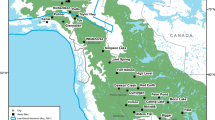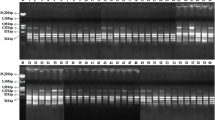Abstract
Many anthropic activities, such as deforestation, agriculture, livestock production, and urbanization, can negatively affect the Cerrado biodiversity. The intense fragmentation of the Cerrado produced by human activities results in the decline of biological populations, loss of genetic diversity, loss of habitat, and extinction of species. The objective of this study was to analyze the genetic diversity between and within five populations of Dipteryx alata, a native species to the Cerrado, using ten microsatellite markers, to support the management and conservation of the species. The genetic diversity of the populations studied was verified through the mean number of alleles (5.36), observed heterozygosity (Ho = 0.82), and expected heterozygosity (He = 0.62). Thus, genetic diversity was considered high, where more than 90% is distributed within populations. A high but non-significant positive correlation was detected between the genetic and geographic distances of the groups of individuals in the fragments (r = 0.69, p = 0.18). However, G’ST values indicated a low genetic differentiation between populations, reaffirmed by the analysis of the structured program, which indicated that there were two levels of structuring, with three to four clusters in the sample, suggesting that these natural populations were structured in the past as a continuous population.



Similar content being viewed by others
Availability of Data and Material
The datasets supporting the results of this article are included in the article and supplementary material.
Code Availability
Not applicable.
References
Alencar A, Shimbo JZ, Lenti F, Balzani Marques C, Zimbres B, Rosa M, Arruda V, Castro I, Fernandeś M ́arcico Ribeiro JP, Varela V, Alencar I, Piontekowski V, Ribeiro V, Bustamante MMC, Eyji Sano E E, Barroso M (2020) Mapping three decades of changes in the brazilian savanna native vegetation using landsat data processed in the google earth engine platform. Remote Sens 12:924. https://doi.org/10.3390/rs12060924
Arakaki AH, Spier MR, Miyaoka M, Candil RFM, da Costa RB, Scheidt GN (2008) Potencialidades e utilização do baru (Dipteryx alata Vog.) em assentamento rural no estado do Mato Grosso do Sul. Redes (Santa Cruz do Sul Online) 13:37–46. https://doi.org/10.17058/redes.v13i3.779
Batista FO, Sousa RS de (2019) Bioactive compounds in fruits pequi (Caryocar brasiliense Camb.) and baru (Dipteryx alata Vogel) and their potential uses: a review. Braz J Dev 5:9259–9270. https://doi.org/10.34117/bjdv5n7-120
Boni TS, Maltoni KL, Buzetti S, Cassiolato AMR (2016) Avaliação comparativa do estado nutricional de mudas de baru (Dipteryx alata). Ciência Florestal 26:109–121. https://doi.org/10.5902/1980509821095
Caballero A, Rodríguez-Ramilo ST, Ávila V, Fernández J (2010) Management of genetic diversity of subdivided populations in conservation programmes. Conserv Genet 11:409–419. https://doi.org/10.1007/S10592-009-0020-0
Carrazza LR, Ávila JCC (2010) Manual tecnológico de aproveitamento integral do fruto do baru. (ISPN), Brasília, Brasil
Collevatti RG, Telles MPC, Nabout JC, Chaves LJ, Soares TN (2013) Demographic history and the low genetic diversity in Dipteryx alata (Fabaceae) from brazilian neotropical savannas. Heredity 111:97–105. https://doi.org/10.1038/hdy.2013.23
da Cruz KS, da Silva MA, de Freitas O, Neves VA (2011) Partial characterization of proteins from baru (Dipteryx alata Vog) seeds. J Sci Food Agric 91:2006–2012. https://doi.org/10.1002/jsfa.4410
da Silva RW, Machado SS, de Cassia Faria K, de Souza AP, de Oliveira FA, de Menezes IP, Silva JM (2021) Development, characterization and genetic diversity of new microsatellite markers for Dipteryx alata Vogel, a species with multiple uses in the brazilian Cerrado. Res Sq Company 1:1–10. https://doi.org/10.21203/rs.3.rs-629013/v1
da Souza CRS, Monego ET, Santiago RAC (2020) Quilombolas traditional knowledge, use and characterization of the biodiversity of the Cerrado Goiano. Braz J Dev 6:38383–38393. https://doi.org/10.34117/bjdv6n6-399
Dias NLS, Ferreira RL (2017) Auditoria ambiental nas queimadas de cana-de-açúcar para reposição da fauna e flora. Meio Ambiente e Sustentabilidade 5:67–85
Diniz-Filho JAF, Soares TN, Lima JS, Dobrovolski R, Landeiro VL, de Telles MP, C, Rangel TF, Bini LM (2013) Mantel test in population genetics. Genet Mol Biol 36(4):475–485. https://doi.org/10.1590/S1415-47572013000400002
dos Santos MZF, de Cristo SSV, Moreira CJ (2019) Unidades de conservação da natureza como estratégia de conservação socioambiental. Revista Interface (porto Nacional) 18:64–78
Doyle JJ, Doyle JL (1990) Isolation of plant DNA from fresh tissue. Focus 12:13–15
Earl DA, Vonholdt BM (2012) Structure Harvester: a website and program for visualizing structure output and implementing the Evanno method. Conserv Genet Resour 4:359–361. https://doi.org/10.1007/s12686-011-9548-7
Evanno G, Regnaut S, Goudet J (2005) Detecting the number of clusters of individuals using the software structure: a simulation study. Mol Ecol 14:2611–2620. https://doi.org/10.1111/j.1365-294X.2005.02553.x
Falush D, Stephens M, Pritchard JK (2003) Inference of population structure using multilocus genotype data: linked loci and correlated allele frequencies. Genetics 164:1567–1587. https://doi.org/10.1093/genetics/164.4.1567
Fernandes RC (2008) Diversidade e estrutura genética em populações naturais de pequizeiro (Caryocar brasiliense Camb.) no norte de Minas Gerais. Dissertação, Universidade Federal de Lavras
Gois IB, Ferreira RA, Silva-Mann R (2018) Genetic variability in natural populations of Cassia grandis L. F Floresta e Ambiente. https://doi.org/10.1590/2179-8087.160309
Guimarães RA, Miranda KMC, Mota EES, Chaves LJ, Telles MPC, Soares TN (2019) Assessing genetic diversity and population structure in a Dipteryx alata germplasm collection utilizing microsatellite markers. Crop Breed Appl Biotechnol 19:329–336. https://doi.org/10.1590/1984-70332019v19n3a45
Hedrick PW (2005) A standardized genetic differentiation measure. Evolution 59:1633–1638. https://doi.org/10.1111/j.0014-3820.2005.tb01814.x
Kearse M, Moir R, Wilson A, Stones-Havas S, Cheung M, Sturrock S, Buxton S, Cooper A, Markowitz S, Duran C, Thierer T, Ashton B, Meintjes P, Drum- mond A (2012) Geneious Basic: an integrated and extendable desktop software platform for the organization and analysis of sequence data. Bioinformatics 28:1647–1649. https://doi.org/10.1093/bioinformatics/bts199
Klink C, Machado R (2005) Conservation of the brazilian Cerrado. Conserv Biol 19:707–713. https://doi.org/10.1111/j.1523-1739.2005.00702.x
Marimon-Junior BH, Haridasan M (2005) Comparação da vegetação arbórea e características edáficas de um cerradão e um cerrado sensu stricto em áreas adjacentes em solos distróficos no leste de Mato Grosso, Brasil. Acta Botanica Brasilica 19:913–926. https://doi.org/10.1590/S0102-33062005000400026
Marimon BS, Felfili JM, Lima ES, Duarte WMG, Marimon-Junior BH (2010) Environmental determinants for natural regeneration of gallery forest at the Cerrado/Amazonia boundaries in Brazil. Acta Amazon 40:107–118. https://doi.org/10.1590/S0044-59672010000100014
Marques EQ, Marimon-Junior BH, Marimon BS, Matricardi EAT, Mews HA, Colli GR (2020) Redefining the Cerrado-Amazonia transition: implications for conservation. Biodivers Conserv 29:1501–1517. https://doi.org/10.1007/s10531-019-01720-z
Martins APV (2011) Desenvolvimento de marcadores microssatélites e variabilidade genética em populações de Vellozia gigantea (Velloziaceae), espécie endêmica dos campos rupestres da Serra do Cipó. Dissertação, Universidade Federal de Minas Gerais
Mendonça RC, Felfili J.M, Walter BMT, Silva J, Rezende AB, Filguerias TS, Nogueira PE, Fagg CW (2008) Flora vascular do bioma Cerrado: checklist com 12.356 espécies. Cerrado: Ecologia e Flora 2:422–442
Nei M (1987) Molecular evolutionary genetics. Columbia University Press New York 512. https://doi.org/10.7312/nei-92038
Oliveira MIB, Sigrist MR (2008) Fenologia reprodutiva, polinização e reprodução de Dipteryx alata Vogel (Leguminosae-Papilionoideae) em Mato Grosso do Sul, Brasil. Braz J Bot 31:195–207. https://doi.org/10.1590/S0100-84042008000200002
Peakall R, Smouse PE (2012) GenAlEx 6.5: genetic analysis in Excel. Population genetic software for teaching and research—an update. Bioinformatics 28:2537–2539. https://doi.org/10.1093/bioinformatics/bts460
Pirani FR, Sanchez M, Pedroni F (2009) Fenologia de uma comunidade arbórea em cerrado sentido restrito, Barra do Garças, MT, Brasil. Acta Bot Brasilica 23:1096–1110. https://doi.org/10.1590/S0102-33062009000400019
Pritchard JK, Stephens M, Donnelly P (2000) Inference of population structure using multilocus genotype data. Genetics 155:945–959. https://doi.org/10.1093/genetics/155.2.945
Ramos TV, Santos LAC, Souza WG, Souza KR, Lima NL, Guimarães LE, Brandão DC, Silva JP, Gonçalves RA, Gonçalves RB, Arruda EM, Calil FN, Silva-Neto CM (2018) Chemical attributes of brazilian Cerrado soil under different management systems. Aust J Crop Sci 12:505–510. https://doi.org/10.21475/ajcs.18.12.03.pne1126
Ribeiro JF, Walter BMT (1998) Fitofisionomias do bioma Cerrado. In: Sano SM, Almeida SP (eds) Cerrado: ambiente e flora. Planaltina Embrapa-CPAC Brasília 87–166
Ribeiro RA, Rodrigues FM (2006) Genética da conservação em espécies vegetais do Cerrado. Revista De Ciências Médicas e Biológicas 5:253–260. https://doi.org/10.9771/cmbio.v5i3.4263
Sander NL, Tiago AV, de Arruda JC, Carniello MA, Silva MTP, Rossi AAB, da Silva CJ (2017) Diversidade genética e estrutura populacional de Mauritia flexuosa L. f. no Cerrado e no Pantanal. Boletim Do Museu Paraense Emílio Goeldi-Ciências Naturais 12:209–219
Sano SM, Ribeiro JF, Brito MA (2004) Baru: Biologia e uso. Embrapa Cerrados, Brasília, Brasil
Sebbenn AM (2002) Número de árvores matrizes e conceitos genéticos na coleta de sementes para reflorestamentos com espécies nativas. Revista Do Instituto Florestal 14:115–132
Soares TN, Chaves LJ, Telles MPC, Diniz-Filho JAF, Resende LV (2008) Landscape conservation genetics of Dipteryx alata (“baru” tree: Fabaceae) from Cerrado region of central Brazil. Genetica 132:9–19. https://doi.org/10.1007/s10709-007-9144-7
Soares TN, Melo DB, Resende LV, Vianello RP, Chaves LJ, Collevatti RG, Telles MPC (2012) Development of microsatellite markers for the neotropical tree species Dipteryx alata (Fabaceae). Am J Bot 99:72–73. https://doi.org/10.3732/ajb.1100377
Soares TN, Diniz-Filho JAF, Nabout JC, Telles MPC, Terribile LC, Chaves LJ (2015) Patterns of genetic variability in central and peripheral populations of Dipteryx alata (Fabaceae) in the brazilian Cerrado. Plant Syst Evol 301:1315–1324. https://doi.org/10.1007/s00606-014-1155-0
Sousa FF, Braga RM, Venturin N, Carlos L, Macedo RLG, Venturin RP (2018) Nutritional requirements of Dipteryx alata seedlings grown under nutrient-limiting conditions. Ciência Florestal 28:102–114. https://doi.org/10.5902/1980509831586
Strassburg BBN, Brooks T, Feltran-Barbieri R, Iribarrem A, Crouzeilles R, Loyola R, Latawiec AE, Oliveira FJB, Scaramuzza CAD, Scarano FR, Soares B, Balmford A (2017) Moment of truth for the Cerrado hotspot. Nat Ecol Evol 1:1–3. https://doi.org/10.1038/s41559-017-0099
Tambarussi EV, Sebben AM, Alves-Pereira A, Vencovsky R, Cambuim J, Silva AM, Moraes MA, Moraes MLT (2017) Dipteryx alata Vogel (Fabaceae), a neotropical tree with high levels of selfing: implications for conservation and breeding programs. Ann For Res 60:243–261. https://doi.org/10.15287/afr.2017.842
Takemoto E, Okada IA, Garbelotti ML, Tavares M, Aued-Pimentel S (2001) Chemical composition of seeds and oil of baru (Dipteryx alata Vog.) native from Pirenópolis, state of Goiás. Brazil Instituto Adolfo Lutz 60:113–117
Tarazi R, Moreno MA, Gandara FB, Ferraz EM, Moraes MLT, Vinson CC, Ciampi AY, Vencovsky R, Kageyama PY (2010) High levels of genetic differentiation and selfing in the brazilian Cerrado fruit tree Dipteryx alata Vog. (Fabaceae). Genet Mol Biol 33:78–85. https://doi.org/10.1590/S1415-47572010005000007
Telles MPC, Silva SP, Ramos JR, Soares TN, Melo DB, Resende LV, Batista EC, Vasconcellos BF (2010) Genetic structure of natural populations of Tibouchina papyrus (pau-papel) in areas of cerrado rupestrian fields. Braz J Bot 33:291–300. https://doi.org/10.1590/S0100-84042010000200010
Vieira MLC, Santini L, Diniz AL, Munhoz CF (2016) Microsatellite markers: what they mean and why they are so useful. Genet Mol Biol 39:312–328. https://doi.org/10.1590/1678-4685-GMB-2016-0027
Vinson CC, Ribeiro DO, Harris SA, Sampaio I, Ciampi AY (2009) Isolation of polymorphic microsatellite markers for the tetraploid Dipteryx odorata, an intensely exploited Amazonian tree species. Mol Ecol Resour 9:1542–1544. https://doi.org/10.1111/j.1755-0998.2009.02694.x
Wang J (2012) On the measurements of genetic differentiation among populations. Genet Res 94:275–289. https://doi.org/10.1017/S0016672312000481
Funding
This work was financially supported by grants from the Partnerships for Forests (P4F-0641). RWLS received a scholarship by the Brazilian Coordination for the Improvement of Higher Education Personnel (CAPES). FAO received a postdoctoral fellowship from São Paulo Research Foundation (FAPESP 2018/18527–9).
Author information
Authors and Affiliations
Contributions
All authors contributed equally to this manuscript.
Corresponding author
Ethics declarations
Ethics Approval
This article does not include studies about humans or animals performed by any of the authors.
Consent to Participate
Not applicable.
Consent for Publication
Not applicable.
Conflict of Interest/Competing Interests
The authors declare no competing interests.
Additional information
Publisher's Note
Springer Nature remains neutral with regard to jurisdictional claims in published maps and institutional affiliations.
Supplementary Information
Below is the link to the electronic supplementary material.
Rights and permissions
Springer Nature or its licensor holds exclusive rights to this article under a publishing agreement with the author(s) or other rightsholder(s); author self-archiving of the accepted manuscript version of this article is solely governed by the terms of such publishing agreement and applicable law.
About this article
Cite this article
da Silva, R.W.L., Machado, S.S., de Cassia Faria, K. et al. Diversity and Genetic Structure of Dipteryx alata Vogel (Fabaceae) Populations in the Cerrado-Amazon Ecotone, Brazil. Plant Mol Biol Rep 41, 218–228 (2023). https://doi.org/10.1007/s11105-022-01360-8
Received:
Accepted:
Published:
Issue Date:
DOI: https://doi.org/10.1007/s11105-022-01360-8




